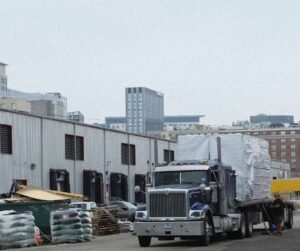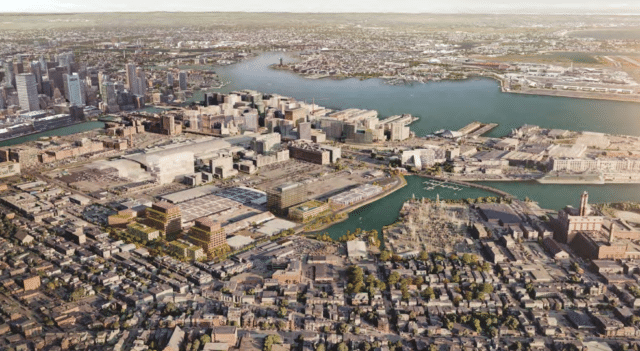
Oxford Properties Group is spearheading a plan to redevelop a large spread of warehouses south of Boston’s Seaport District. Photo by James Sanna | Banker & Tradesman staff
The first decade of the Boston Seaport District development boom was the real estate industry’s chance to pluck low-hanging fruit: replacing sprawling parking lots with glassy office buildings and high-end apartment and condominium towers in a period of resurgent urban living and workplaces.
In a current era of rising seas and ebbing commercial leasing, Oxford Properties Group and the owners of Pappas Commerce Center have to navigate a trickier path at the Seaport’s next major development. Developers are planning to elevate the 42-acre site to tie into the city of Boston’s emerging coastal defense strategy, while anticipating the changing demand drivers for commercial real estate in coming decades.
Named after the waterway that runs along its eastern edge, the Reserved Channel project envisions replacing industrial buildings, bus storage yards and parking lots with up to 6 million square feet of development. The parking lots and warehouses would gradually make way for a grid of 12 blocks bridging the Seaport’s commercial-industrial cluster with South Boston residential neighborhoods.
Missed Opportunity for Housing Production?
The first phase includes 2 acres owned by Pappas Enterprises and nearly 11 acres that it leases from the Massachusetts Port Authority. It’s positioned to attract demand for higher-rent-paying uses, with five new commercial and lab-ready buildings totaling 1.4 million square feet that represent 83 percent of the new development.
Developers’ emphasis on commercial uses has attracted scrutiny during public meetings, as some community members have warned of a missed opportunity for large-scale housing production. Some have cited Gov. Maura Healey’s edict instructing state agencies to identify publicly owned parcels suitable for housing production. The Reserved Channel proposal includes 205 housing units in the first phase, and 847 in the entire 6 million-square-foot master plan.
Developers have stated they’re committed to “diverse housing options,” including senior housing, workplace or family-sized housing, but haven’t commented on a potential larger residential component.
In a statement, the development team said it’s “looking forward to working with stakeholders to be responsive to priorities” after the close of the MEPA and BPDA comment periods on June 7.
Massport awarded its first parcel for an income-restricted housing project in its Seaport District portfolio in 2023, for a 200-unit project on D Street that is still in predevelopment. Unlike some communities, Boston does not require a minimum percentage of housing in large-scale developments. In 2023 rezoning, the city of Cambridge required major developments to include multifamily housing in the Quadrangle district off Concord Avenue, following an uptick in lab development proposals.
Targeting Higher and Better Uses

Nearly two-thirds of the 785,000 square feet of existing space at Pappas Commerce Park is occupied by industrial uses. Photo by James Sanna | Banker & Tradesman Staff
Pappas Enterprises, a fourth-generation family-owned development business, has leased the property built on former mud flats from Massachusetts Port Authority since 1965.
The sprawling site occupied by eight low-rise commercial buildings has maintained a low profile during the Seaport District transformation of the past decade. Nearly two-thirds of the 785,000 square feet of existing space is occupied by industrial uses, with major tenants such as UPS, Verizon, bus service Yankee Line and office supplier W.B. Mason.
But the life science industry has started to make inroads: Biotech Akouos and publicly traded medical device manufacturer 908 Devices occupy a 2-story lab building at 645 Summer St. converted in 2018.
The success of the lab building awakened Pappas Enterprises to the potential transformation of the property, and prompted it to partner with Oxford Properties Group, Pappas Enterprises CEO Timothy Pappas said in an introductory presentation to CAC members in April. In 2019, Pappas formed a joint venture with the deep-pocketed pension fund manager.
As long-term leases expire, the business park gradually could shed its gritty industrial past and fill newly constructed buildings with emerging industry tenants such as robotics and artificial intelligence, developers say.
The redevelopment plan envisions a 30-year expansion of density, starting at the southern end of the property facing West 1st St., where three commercial buildings and the two multifamily buildings would be built ranging from 5 to 11 stories. A pair of 4- and 10-story commercial buildings would replace the UPS facility at 647B Summer St. The first phase also includes a small civic pavilion building.
Ultimately, the project could include nearly 6 million square feet of development built in a new grid of 12 blocks over 30 years, according to documents submitted to the Massachusetts Environmental Policy Act office.
Reshaping the Shoreline Again

After taking a backseat to the Seaport District development boom, the 42-acre Pappas Commerce Park could expand to 6 million square feet of development in coming decades. Image courtesy of SOM and Stantec
With a projected 30-year timeline for its complete buildout, the Reserved Channel project could rise amid a dramatically different coastal landscape in the coming decades. The property itself was built on filled land previously occupied by mud flats until the 1950s, but remains vulnerable to storm surges and rising seas. And with sea levels expected to rise 40 inches by 2070, large portions of the property would be inundated by flood waters during monthly high tides, according to project documents.
Massport has been in discussions with the Boston Planning & Development Agency and other nearby private property owners including Eversource about a coordinated plan for the channel flood defense, Massport Chief Development Officer Andrew Hargens said.
Gina Wirth, design principal and partner at New York-based Scape Landscape Architecture, said developers expect to include strategies such as rain gardens, reconstructed wetlands, permeable pavers and vegetated roof materials in the resiliency plan.
The project will connect to flood barriers envisioned in the city’s Coastal Resilience for South Boston study. Final versions of the city plan, along with funding sources and timing, have yet to be determined.

Steve Adams
Public comment periods for both the BPDA and MEPA reviews were due to expire on June 7. The project is exempt from Boston zoning because of Massport’s ownership, but is undergoing a voluntary review with the BPDA.
In a statement, developers said the current proposal reflects two years of outreach conducted before the submission.
“The proposed project will achieve a number of important goals, including new neighborhood-focused housing, advanced resiliency, incredible open space and additional economic opportunity. Our team wanted to both develop a strong planning framework and balance measured growth, which led us to approach the site in a phased manner,” developers stated.
Overlooked Development Frontier Takes Center Stage #Overlooked #Development #Frontier #Takes #Center #Stage
Source Link: https://bankerandtradesman.com/overlooked-development-frontier-takes-center-stage/
Overlooked Development Frontier Takes Center Stage:
Oxford Properties Group is spearheading a plan to redevelop a large spread of warehouse…
